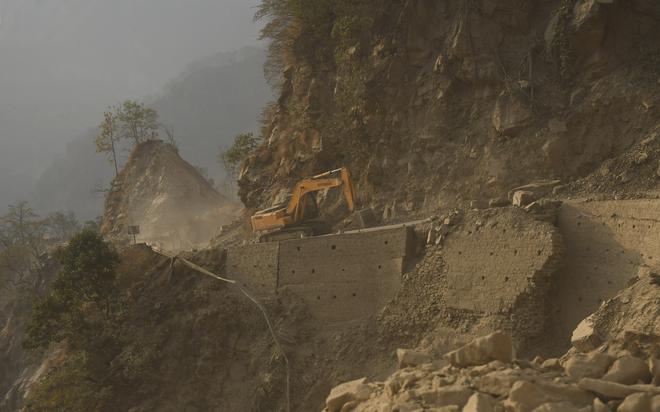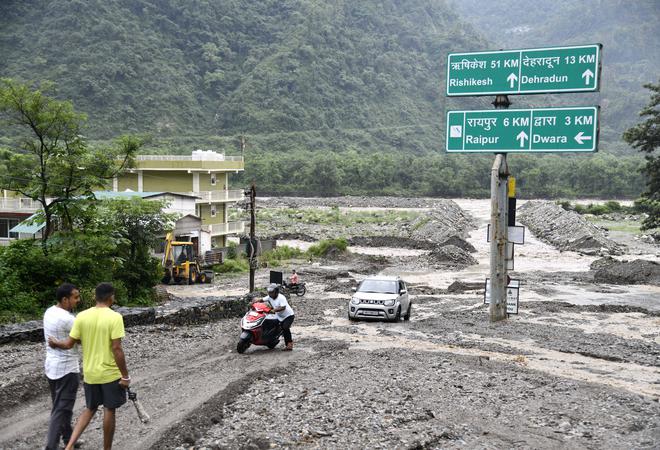Wonder-struck by the beauty and the magnificence of the Himalaya, an ancient Sanskrit poet wrote, “In a thousand ages of the gods, I could not tell you of the glories of the Himalaya.” The snow-covered peaks, though increasingly diminishing, may still awaken the poet in us, but the barrenness of the hills below tell us the real story — that of steady environmental depredation. Today, the repeated tragedies of bridges, roads and buildings being swept by raging rivers in the hill States of Uttarakhand and Himachal Pradesh, epitomise a flawed developmental paradigm institutionalised in an eco-fragile region. Blocked roads after a landslide at Chamoli and sinking in Joshimath in Uttarakhand, road caving in Chamba in Himachal, accidents on the Char Dham routes, and deaths on the all-weather road are reports that have become everyday news from “Devbhoomi” (land of the gods).

Road project, bypassing the rules
In 2016, the Chardham Mahamarg Vikas Pariyojna, a massive infrastructure project of 900 kilometre of road widening to double-laning with a paved shoulder (DLPS) design of 12m was implemented in the Garhwal region and a short stretch of Kumaon in Uttarakhand. The project has claimed lakhs of trees and acres of forest land, many human and animal lives, and also the fertile topsoil of the fragile Himalaya. The tons of muck generated have choked water sources. By law, a project of more than 100 km needs environmental clearance. But ambitious projects for tourism and plans that are the result of election agendas are time bound. All laws of land are bypassed. In this case, this massive project was broken up into 53 small projects, each less than 100 km long, thus by-passing environmental impact assessment (EIA) requirements.
The dense forests around Chamba, Agrakhal Maletha, Shivpuri, Rudraprayag, Chamoli, Agustmuni, Karnaprayag and Kund (all Uttarakhand) and other such lush green sites are vanishing. Amid the rapacious nature of the Chardham Mahamarg Vikas Pariyojna, only one pristine patch, i.e., the Bhagirathi Eco Sensitive Zone (BESZ), remains.
BESZ has the only natural free flow that is left of the Ganga river and was declared a protected site in December 2012 under the Environment Protection Act, 1986. This stretch of approximately 100 km could not be touched by the Chardham Mahamarg Vikas Pariyojna project without an approved zonal master plan (ZMP) and a detailed EIA. To facilitate the Chardham Mahamarg Vikas Pariyojna, the ZMP was given hasty approval, negating the directions of even the Supreme Court of India. The mandatory and detailed EIA was not done. And, finally, the BESZ monitoring committee’s approval was overseen by most of the State officials on the committee without any discussion or suggestions being made. Thus, thousands of deodar trees and kilometres of pristine mountain slopes face grave danger due to the same devastative DLPS road width.

Unanswered questions, violations
By widening hill roads to DLPS alignment, the Ministry of Road Transport is only contradicting its own notification which says: “However, challenges have come to the fore in adhering to these standards [i.e., DLPS] in the context of national highways and roads in hilly and mountainous terrains. These challenges arise on account of [a] destabilization of hill slopes and progressive damaging effects on road alignments and structures”. It goes on to recommend: “The carriageway width shall be of intermediate lane configurations, i.e. of 5.5 m width (18 ft), with two-lane structures (23 ft.).” The Supreme Court itself took cognisance of this contradiction in civil appeal 10930/2018 when a Bench headed by Justice R. Nariman reprimanded the Ministry and directed implementation of its own notification “prospectively and retrospectively” in September 2020. But the government produced the reason of “national security”. Eventually, a Bench headed by Justice D.Y. Chandrachud in December 2021 permitted the government to do whatever it desired. No questions were asked.
A review is called for as there are many unanswered questions. Why did the Defence Ministry which wanted a two-lane seven metre width road in the first place, change its requirement to one of DLPS road-width standard? Why is double lane road-width sufficient in the border areas while a so-called feeder road which is 80 km away from the border in the BESZ region being widened to DLPS standard? How is a vulnerable road-width design that leads to unstable mountain slopes suitable for a strategic road? Why did the Road Transport Ministry suggest a double laned road-width for BESZ but change its stance two months later? Why is a BESZ road widening project being allowed without a mandatory EIA? Why was the Chardham Mahamarg Vikas Pariyojna project implemented with DLPS road-width when its own circular suggested otherwise? When the Chardham Mahamarg Vikas Pariyojna was announced, only the core reason of “faster” movement of vehicular traffic was stated. Why and when was this project changed to one of strategic importance?
Before the monsoons, the Uttarakhand government increased the carrying capacity of all the Char Dhams while the carrying capacity for the Gangotri shrine (i.e., BESZ) was increased to 9,000 passenger carrying units per day even though the BESZ notification calls for a “regulation of vehicular traffic”. While experts have repeatedly pointed out that the Chardham shrines of Uttarakhand are already overburdened, their carrying capacities have been increased ignoring all scientific rationale to blindly boost the tourism sector and perhaps to justify the excessively road widening that the government is pursuing in the most vulnerable section of Himalaya. However, after the recent warning signals by mother nature, the State governments of Uttarakhand and Himachal Pradesh propose a reassessment of carrying capacity. The Supreme Court too is setting a committee for the same, but the larger question is whether the recommendations will be implemented or not.
BESZ has witnessed several disasters in the past. For such sensitive regions, the Parliamentary Standing Committee on Science and Technology, Environment, Forests and Climate Change has pointed out to the Ministry of Environment, Forest and Climate Change that “The Committee also believes that a one size fits all approach to environment clearance should not be followed, especially for the ecologically sensitive areas of the country such as in Joshimath, Mussoorie and Dhanaulti, which require a more meticulous approach with the only aim of furthering the environmental interests rather than economic interest.”
Saving the Gangotri, need for regulation
One of the most challenging issues for the Ganga’s rejuvenation is conservation of the Gangotri glacier, which is also the fastest receding glacier. With an increase in vehicular movement and episodes of forest fires, black carbon deposits (carbon plus soot) are rising on the glacier, escalating its melting. Another Standing Committee report of March 2023 on water resources says, “Black carbon absorbs more light and emits infra-red radiation that increases the temperature. Therefore, an increase in black carbon in the high Himalaya contributes to the faster melting of glaciers.” Imagine the heating rod-like effect of a 12m wide tarred road in the vicinity of this glacier.
Greed outstripping need along with manipulative political, bureaucratic and real estate lobbies is destroying the Himalayan forests and rivers and lives of local inhabitants. In the persistent debate of environment versus development of the hills, there is a very simple solution to all the chronic and acute problems that the hills face — regulation. In BESZ, the upgradation of roads to an intermediate road width, that will have minimal environmental impact, is the only possible and sustainable solution. If reducing a few metres of road width helps ensure the conservation of the only pristine stretch of the Ganga and protection of the Himalaya, then we must make sincere efforts to amend the plan. We live in times of the critical and unpredictable impact of climate change events which call for prevention and conservation. Most importantly, no development can be sustained if it ends up destroying the main lifeline for millions of people and future generations.
Mallika Bhanot is a member of Ganga Ahvaan, a citizen forum working towards conserving the Ganga and the Himalayas. She is also a member of Bhagirathi Eco Sensitive Zone (BESZ) monitoring committee. C.P. Rajendran is an Adjunct Professor at the National Institute of Advanced Studies, Bengaluru, and a director of the Consortium of Sustainable Development, Connecticut. He is the author of a forthcoming book, The Rumbling Earth: The Story of Indian Earthquakes







